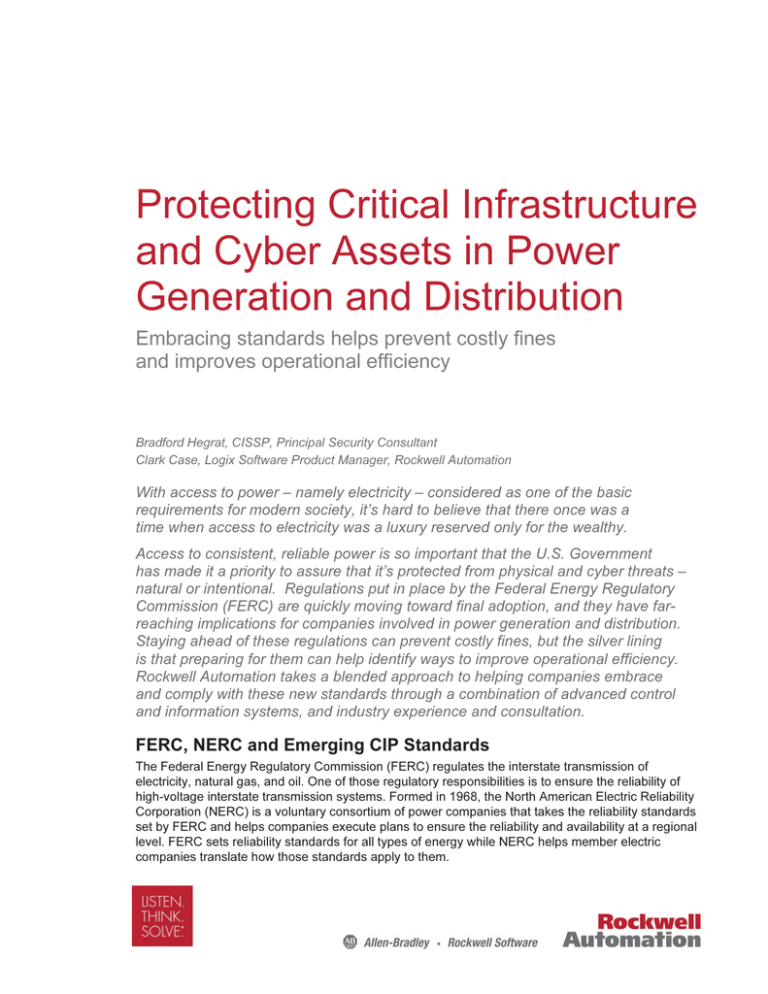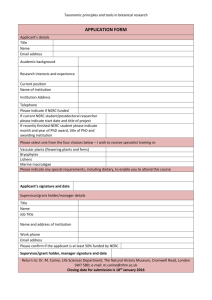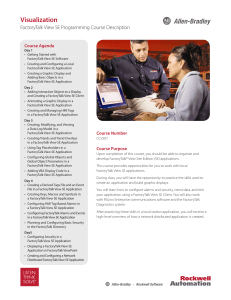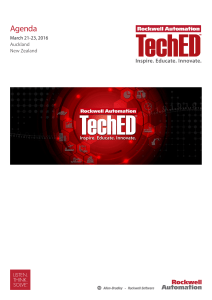
Protecting Critical Infrastructure
and Cyber Assets in Power
Generation and Distribution
Embracing standards helps prevent costly fines
and improves operational efficiency
Bradford Hegrat, CISSP, Principal Security Consultant
Clark Case, Logix Software Product Manager, Rockwell Automation
With access to power – namely electricity – considered as one of the basic
requirements for modern society, it’s hard to believe that there once was a
time when access to electricity was a luxury reserved only for the wealthy.
Access to consistent, reliable power is so important that the U.S. Government
has made it a priority to assure that it’s protected from physical and cyber threats –
natural or intentional. Regulations put in place by the Federal Energy Regulatory
Commission (FERC) are quickly moving toward final adoption, and they have farreaching implications for companies involved in power generation and distribution.
Staying ahead of these regulations can prevent costly fines, but the silver lining
is that preparing for them can help identify ways to improve operational efficiency.
Rockwell Automation takes a blended approach to helping companies embrace
and comply with these new standards through a combination of advanced control
and information systems, and industry experience and consultation.
FERC, NERC and Emerging CIP Standards
The Federal Energy Regulatory Commission (FERC) regulates the interstate transmission of
electricity, natural gas, and oil. One of those regulatory responsibilities is to ensure the reliability of
high-voltage interstate transmission systems. Formed in 1968, the North American Electric Reliability
Corporation (NERC) is a voluntary consortium of power companies that takes the reliability standards
set by FERC and helps companies execute plans to ensure the reliability and availability at a regional
level. FERC sets reliability standards for all types of energy while NERC helps member electric
companies translate how those standards apply to them.
2 | Protecting Critical Infrastructure and Cyber Assets in Power Generation and Distribution
While power companies have had safeguards to protect physical and human assets in place for some
time, the emergence of new technologies that allow for long-distance control and information sharing
within the power infrastructure has created the possibility of threats coming from the Internet rather
than the physical world.
In order to continue its mission, NERC developed a set of enforceable reliability standards that must
be followed by companies responsible for the reliability and availability of the Bulk Electric System
(BES) in North America. The standards specifically pertaining to the identification and protection of
Cyber Critical Assets are known as the NERC Critical Infrastructure Protection (CIP) standards,
more commonly referred to as NERC CIP standards.
Cyber Critical Assets are the devices used to support the day-to-day operation of Critical Assets
and the distribution of electricity to the BES. A Critical Asset is one which is necessary to maintain
the reliability of the BES, such as a generating unit with blackstart capacity (i.e. a unit that does not
require a secondary power source for initial startup purposes). Guidelines for identifying Cyber
Critical Assets are contained in the NERC CIP standard CIP-002-1. A broad majority of companies
do not recognize that they own or operate Critical Assets, at least when it comes to complying with
the NERC CIP standards. When NERC completed its 2009 self-certification compliance survey for
CIP-002-1, it found that less than one-third of generation owners and operators had identified at least
one Critical Asset within their facilities.
The primary reason for the low number of Cyber Critical Assets identified by generation owners is
the ambiguous language used in NERC-CIP-002-1. This is currently under review and revision by
NERC and FERC.
Investments to meet NERC CIP standards could significantly increase operating budgets which in
turn will drive costs and power prices upward. This is a real concern for generation owners as their
market evolves toward a “Smart Grid” requiring them to be the “low cost” power provider. However,
sanctions for noncompliance to the NERC CIP standards are also significant, with fines reaching up
to $1 million per day. Finding a clear path amidst the confusion is critical for generation owners. The
end result will reach beyond simply checking off another box in a long regulatory checklist. Reaching
an appropriate balance of the investment needed to be competitive while simultaneously complying
with NERC CIP is essential and will dramatically influence the growth or loss of the generation
owner’s customer base.
A brief overview of NERC CIP
There are key resources, which can be publicly or privately controlled, that are essential to the
minimal operations of the economy and government. These are collectively known as the Critical
Infrastructure. The power generation and distribution system makes up an important part of the
Critical Infrastructure. In order to protect this portion of the Critical Infrastructure, NERC developed
the NERC CIP standards. The primary objective of the NERC CIP standards is to help assess the
reliability of each facet within the power infrastructure, evaluate power companies’ preparedness
in the face of an attack or unplanned interruption of operations, and to continue education and
awareness for employees of these companies. As defined by NERC, Critical Infrastructure Protection
covers “the assets, systems and networks, whether physical or virtual, considered so vital to the
United States that their incapacitation or destruction would have a debilitating effect on security,
national economic security, public health or safety, or any combination thereof.”
3 | Protecting Critical Infrastructure and Cyber Assets in Power Generation and Distribution
The NERC regulations boil down to eight standards. At Rockwell Automation, we’ve found greater
simplicity and speed in the compliance process by dividing these eight standards into three groups.
Plan to protect your Cyber Critical Assets.
CIP-003-1, -007-1, -008-1, and -009-1 all offer guidance on how to secure individual assets within a
system. These standards include requirements for identifying the owners of cyber critical assets and
for documenting exceptions to those cyber critical assets. They also have requirements for applying
standards that protect the information associated with those assets and similarly include an annual
evaluation of managing these security controls. Maintaining these security standards is also defined
within this set of four standards, as are guidelines for reporting and responding to a system threat
and recovery recommendations in the event that a company loses access to an asset.
Know what you’ve got and where it is
With CIP-002-1 and -005-1, the most important step companies can take is to understand what
Critical Assets exist within a system, and what cyber critical assets are essential to the operation
of those Critical Assets. Examples can include systems and facilities at master and remote sites
that provide monitoring and control, real-time power system modeling, and real-time inter-utility
data exchange. With those assets identified, companies must then ensure and document that every
cyber critical asset resides within an electronic security perimeter. This perimeter needs to include
electronically monitored access control, as well as an annual review of the perimeter’s cyber
vulnerability.
Tend to the physical security of your assets.
While many already have addressed physical security, CIP-004-1 and -006-1 standards direct
companies how to create and maintain a physical security plan that complements the cyber security
measures already in place, with requirements for documenting physical access controls. Additionally,
these standards address the need to ensure that companies have proper screening processes in
place for hiring personnel, and that all employees are aware of the security measures used and
are trained on how to use them.
Implications of NERC CIP noncompliance
In an industry that’s already regulated, the introduction of new standards always prompts a review of
how these standards will affect or change current operating systems. From an operations standpoint,
these standards mean more systems testing and more paperwork — unwelcome news to companies
operating with margins that are already stretched thin. In addition, the standards also will have an
impact on how control systems are put together to ensure compliance is maintained during system
upgrades or expansions.
Yet, the imperative for understanding how compliance applies, and documenting how systems are in
compliance, is clear in how violations are reported and sanctions are meted. Once an incident of
noncompliance is confirmed by NERC, it is posted to a public forum where it is widely accessible.
Companies found in noncompliance are required to submit a mitigation plan detailing how it will be
brought back into full compliance. Fines are then assessed to the company based on calculations
involving the timeframe of the violation; whether repetitive violations were recorded; any failure to
comply with compliance directives; if the violation was intentional or if company representatives
attempted to conceal the violation; how cooperative the company was during the investigation; any
self-disclosure or voluntary corrective actions undertaken by the company; and other extenuating
circumstances. Fines start at $1000 per day, and can go up to $1,000,000 per day for the most
blatant and egregious violations.
4 | Protecting Critical Infrastructure and Cyber Assets in Power Generation and Distribution
As is the case with many regulatory standards, compliance can be both a burden and a boon.
Generally speaking, it’s sound business sense to regularly evaluate your systems, identify potential
weaknesses within those systems, and take steps to strengthen those areas. While avoiding fines
may motivate some, there are other business benefits to consider. For example, while power
companies design their systems to optimize efficiencies and maintain continuous operations,
these standards reinforce a sound practice of regularly reviewing critical systems for any potential
vulnerabilities and addressing them before they create an interruption of service or are used as
an inroad for some malicious act. This encourages operations directors to reduce the number of
unknowns that can compromise the stability of a power control system. Avoiding system downtime
means avoiding the costs associated with bringing the system back up and compensating for the
interruption of service.
Rockwell Automation Can Help
Having taken that critical first step in defining your cyber critical assets, finding the most efficient
way to achieve and document your company’s compliance and avoid NERC sanctions is the next.
At Rockwell Automation, we already offer the solutions and services that help you fulfill the NERC
requirements.
Rockwell Automation Network & Security Services can help companies at any point in their progress
toward NERC CIP compliance. Our converged team made up of manufacturing engineers and IT
professionals collaborate with you to help manage the differences between manufacturing and
IT enterprises and their associated risks. This can be done not only through technology, but also
through policies, procedures and behavior — allowing you to achieve your production and business
goals. Our consultants consider where you are in your control system or security lifecycle, and
develop a plan to help improve system reliability and increase overall equipment effectiveness.
From a product perspective, two system-oriented offerings in particular can help you meet NERC
CIP requirements – Rockwell Automation FactoryTalk® Security and FactoryTalk AssetCentre.
The FactoryTalk Services Platform is embedded in all control and information products from Rockwell
Automation including RSLogix, PlantPAx™, FactoryTalk View, FactoryTalk Historian, FactoryTalk
Asset Centre. The FactoryTalk Services platform provides a centralized role based access control
system through a software service called FactoryTalk Security. The FactoryTalk Security architecture
is similar to that of Microsoft Windows and provides many of the same capabilities, plus additional
features customized specifically for the needs of automation systems. FactoryTalk Security controls
user access to applications and devices and provides user authentication and authorization. Using
FactoryTalk Security can help you address several of the NERC CIP requirements. For example:
• CIP-004-1 R4.2 calls for revoking access to Cyber Critical Assets within 24 hours for personnel that
have been terminated. With FactoryTalk Security, an administrator can revoke access to software
products and devices immediately.
• CIP-007-1 R5 contains several requirements in the area of Account Management. With FactoryTalk
Security, you can meet all of these requirements.
5 | Protecting Critical Infrastructure and Cyber Assets in Power Generation and Distribution
FactoryTalk AssetCentre provides you with a set of asset-centric focused tools to securely and
centrally manage your factory and process automation production environments by tracking users'
actions, managing asset configuration files, and providing backup and recovery of operating asset
configurations. With these capabilities, compliance with many CIP requirements is much easier.
For example:
• CIP-003-1 R6 requires a comprehensive change control and configuration management process.
FactoryTalk AssetCentre can be a key technical part of such a process. FactoryTalk AssetCentre
has add-ons which support Calibration Management and Process Device Configuration. The
Calibration Management capability allows for a paperless calibration solution: managing calibration
requirements, specifications, schedules, calibration results and reporting. Process Device
Configuration allows you to access instrument parameters, aids in configuration and commissioning
process devices and helps with diagnostics. Acting as a host system, or frame application, it gives
you the ability to work with multiple vendors’ instruments in one common platform.
• CIP-009-1 R4 calls for a recovery plan to restore Cyber Critical Assets to operation. Configuration
backup and recovery is a core feature of FactoryTalk AssetCentre, and can help make this plan
much easier to execute. FactoryTalk AssetCentre provides control system backup that is integrated
with source control to provide reliable and easy access to the latest control system configuration
file. Both Rockwell Automation and third-party assets are supported.
Rockwell Automation provides information and solutions that help you meet other requirements
as well.
• A list of TCP and UDP ports used by Rockwell Automation products is maintained on our
Knowledgebase, helping you meet CIP-007-1 R2, “Ports and Services”.
• All TechConnectSM subscribers can access results of the Rockwell Automation Patch Qualification
process, in which Microsoft operating system patches are tested for compatibility with Rockwell
Automation software products. Using this service can help you meet CIP-007-1, “Security Patch
Management”.
Make the most of compliance measures
The companies who move the fastest to meet compliance will not only avoid sanctions and fines, but
also offer customers the added assurance that comes with regular security reviews. They can help
ensure the reliability and availability of the power needed to serve homes and businesses throughout
the country. Partnering with Rockwell Automation can help you protect your ability to generate and
distribute the valuable energy resource. Additionally, Rockwell Automation can simultaneously help
you comply with key government standards and regulations designed specifically to protect critical
assets on which the United States critical infrastructure relies.
To learn more about Rockwell Automation’s capabilities to address your compliance needs, visit
http://www.rockwellautomation.com/security. Here you will find information regarding our security
products and services, including a link to our Network & Security Services consultancy.
HU
UH
H
Publication ENET-WP020A-EN-P – July 2010
H
Copyright ©2010 Rockwell Automation, Inc. All Rights Reserved. Printed in USA.






